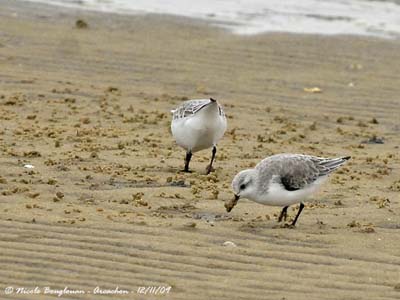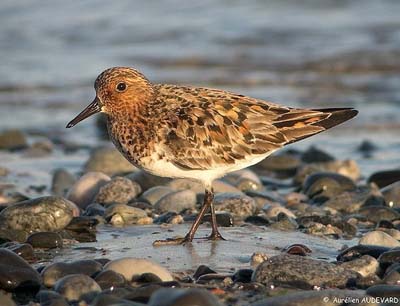
Sanderling
Calidris alba
Charadriiforme Order – Scolopacidae Family
BIOMETRICS :
Length: 20-21 cm
Wingspan: 35-39 cm
Weight: 33-85 g
LONGEVITY: Up to 11 years.
DESCRIPTION:
Sanderling is a medium-sized bird with relatively thick, heavy and short bill. It is a very active bird.
PROTECTION / THREATS / STATUS:
Sanderling is common and widespread.
However, this species is vulnerable to disturbances on the beaches and may move to other quieter area.
Fr : Bécasseau sanderling
All : Sanderling
Esp : Correlimos Tridáctilo
Ital : Piovanello tridattilo
Nd : Drieteenstrandloper
Russe : Песчанка
Sd: Sandlöpare
Photographs by Aurélien Audevard
OUESSANT DIGISCOPING
Other pictures and text by Nicole Bouglouan
Sources :
HANDBOOK OF THE BIRDS OF THE WORLD Volume 3 by Josep del Hoyo-Andrew Elliott-Jordi Sargatal - Lynx Edicions - ISBN : 8487334202
SHOREBIRDS by Peter Hayman, John Marchant and Tony Prater – Christopher Helm – 1986 – ISBN: 0747014035
GUIDE DES LIMICOLES de D. Taylor - Delachaux et Niestlé - ISBN : 2603014080
All About Birds (Cornell Lab of Ornithology)
Wikipedia (Wikipedia, The Free Encyclopedia)

Adult in breeding plumage has chestnut streaked brown head, neck and upperbreast. Upperparts are black with pale dark chestnut fringes, giving scaled effect. Tail is blackish with white outer rectrices. A conspicuous white wing bar is visible in flight in all plumages;
Underparts are pure white.
Bill and legs are black. Eyes are dark brown.
We can find brighter coloured breeding birds, with rich dark chestnut head, upperparts and upperbreast.
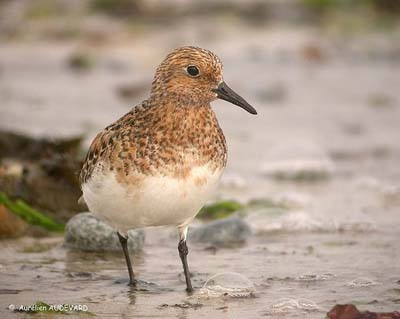
Adult in non-breeding plumage is very pale. Upperparts are pale pearly-grey, slightly spotted darker grey and with blackish carpal patch, more or less visible.
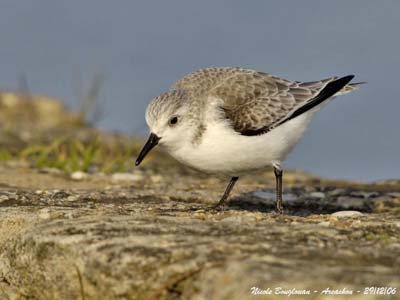
Both sexes are similar, but female is slightly larger and paler, and shows less chestnut.
Juvenile has blackish mantle and scapulars, with buffy-white spots. Wings show blackish and dull brown feathers with paler edges. Breast is slightly tinged buff with streaks on breast sides and almost black shoulder patch.
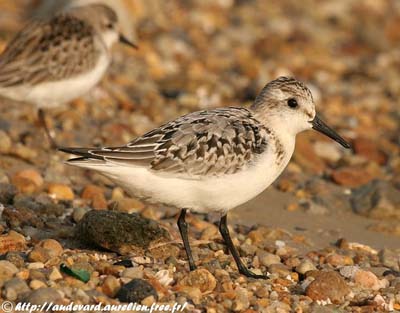
VOICE: SOUNDS BY XENO-CANTO
Sanderling utters sometimes repeated “twick” or “kip” when in flight. We can occasionally hear short trill.
The complex song is given during the aerial displays. It is a chirring uttered in short bursts.
We also hear a soft and continuous chattering in the feeding groups.
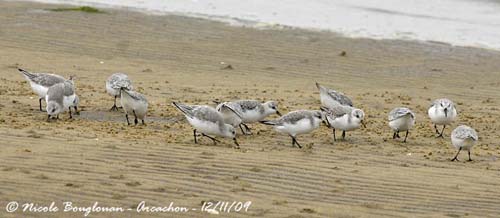
HABITAT:
Sanderling breeds in stony tundra with scant vegetation, sparse growth of willow and saxifrage, and well drained ridges.
They need a good access to the shores for the young birds.
Outside the breeding season, Sanderling frequents open sandy beaches and sandy outer areas of estuaries, rocky or muddy shores.
During migrations, they can be found sometimes at inland waters.
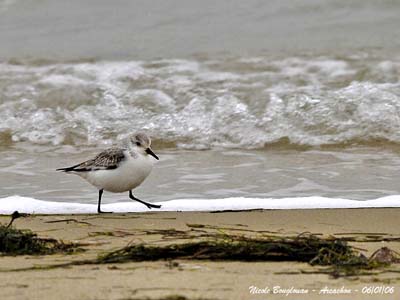
RANGE:
Sanderling breeds in High Arctic areas of North America, Europe and Asia. This species is a long-distance migrant, and travels southwards for wintering in South America, South Europe, Africa and Australia.
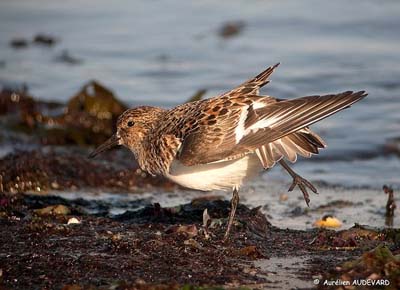
BEHAVIOUR:
Sanderling feeds on various items close to the water’s edge. It probes and pecks rapidly, following the waves’ movements. This bird is able to locate the prey thanks to its smell, touch and taste.
It quickly probes into the sand, repeatedly, while walking or running on the beach. It feeds in small groups of 5 to 20 birds, but also in large flocks. It may feed by day and by night.
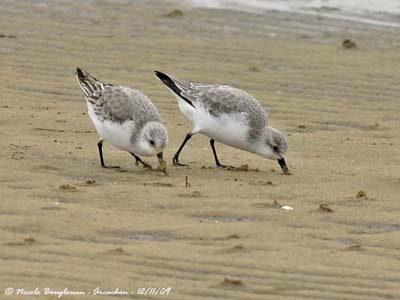
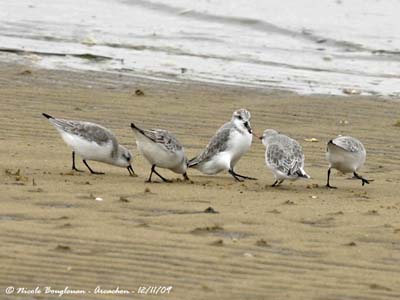
Sanderling defends its feeding territory on wintering areas. They may join large flocks of mixed species for roosting, or they form a monospecific pack on high parts of the beach.
Sanderling is a highly gregarious species outside breeding season, but it becomes solitary for nesting.
During breeding season, male strongly defends the territory. They usually are monogamous, but polyandrous pairing occurs, with one female and two males.
Male performs aerial displays in order to attract females. This flight display is performed fairly low from the ground. Tail is fanned and bill is pointed forwards or slightly downwards, while the bird flies from side to side.
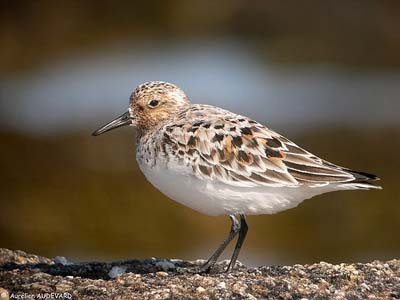
Sanderling is strongly migratory and travels long distances to reach its wintering areas. Migration occurs both offshore and coastal, and frequently inland across North America and Africa. This species seems to have few stopovers along its flyways.
Non-breeding birds commonly remain on the wintering areas in summer.
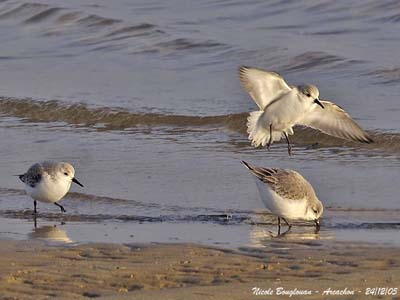
FLIGHT:
Sanderling performs irregular and rapid wing beats, and short glides. Male often performs flycatching, with rapid wing beats interspersed with pauses.
REPRODUCTION:
Breeding season occurs in spring, with laying from June to mid-July.
Sanderling is solitary nester. The nest is on the ground. It is a shallow scrape on bare earth or stones. This depression is often lined with dry leaves and lichens.
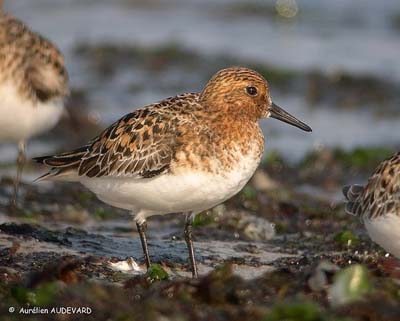
Female lays 3-4 greenish eggs with small brown markings. Incubation lasts about 24 to 32 days, by both parents. Young are able to leave the nest very soon after hatching. Downy chicks are cinnamon-buff above, and white below, with pale buff-yellow face and throat. They fledge about 17 days after hatching.
There often are 2 clutches, each brooded by one parent. A third clutch may occur, probably with a second male.
Both parents care for the chicks. Adults leave the breeding areas soon after the fledging.
A high degree of breeding site fidelity is often noticed.
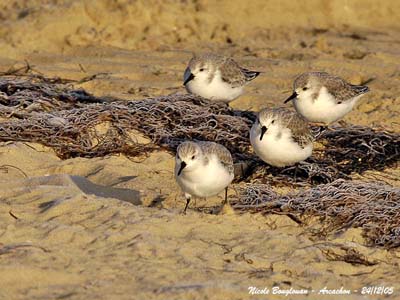
DIET:
Sanderling feeds mainly on insects (adults and larvae), spiders and crustaceans, and some seeds, buds, moss and algae on the breeding grounds.
During the migration and on the wintering areas, it feeds on molluscs, crustaceans, marine worms, insects (adults, larvae and pupae).
It occasionally consumes fish, medusa and larger items as carrion.
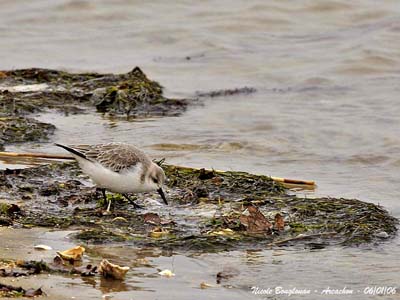
This bird feeds by rapid probing and pecking. We can see bands of holes along the area where they probe into the sand.
